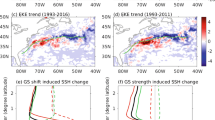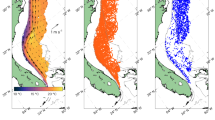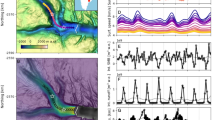Abstract
The Gulf Stream (GS) transports a massive amount of heat northward to high latitudes and releases sensible and latent heat to the atmosphere, playing an important role in the North Atlantic and European climate change. The change trends of the GS transport and pathway are still uncertain to date. Our analyses of altimeter observations from 1993 to 2016 indicate that the linear trends in surface maximum speed, transport, and latitudinal location of the GS are significant east of 61° W at the 95% level while they are small and not significant between 72° W and 61° W. The weakening trend of the GS during the period from 1993 to 2016 is accompanied with a southward-shifting path, which is associated with the decline of the North Atlantic Oscillation (NAO) and possibly reduction in the Atlantic meridional overturning circulation (AMOC).






Similar content being viewed by others
References
Andres M (2016) On the recent destabilization of the Gulf Stream path downstream of Cape Hatteras. Geophys Res Lett 43:9836–9842
Andres M, Donohue KA, Toole JM (2020) The Gulf Stream’s path and time-averaged velocity structure and transport at 68.5°W and 70.3°W. Deep-Sea Res I Oceanogr Res Pap 156:103179
Beal LM, Elipot S (2016) Broadening not strengthening of the Agulhas Current since the early 1990s. Nature 540:570–573
Bisagni JJ, Gangopadhyay A, Sanchez-Franks A (2017) Secular change and inter-annual variability of the Gulf Stream position, 1993–2013, 70°−55°W. Deep-Sea Res I Oceanogr Res Pap 125:1–10
Blunden J, Arndt DS, Hartfield G (2018) State of the climate in 2017. Bull Am Meteorol Soc 99(8):Si–S310
Bryden HL, Johns WE, King BA, McCarthy G, McDonagh EL, Moat BI, Smeed DA (2020) Reduction in ocean heat transport at 26°N since 2008 cools the eastern subpolar gyre of the North Atlantic Ocean. J Clim 33:1677–1689
Caesar L, Rahmstorf S, Robinson A, Feulner G, Saba V (2018) Observed fingerprint of a weakening Atlantic Ocean overturning circulation. Nature 556:191–196
Chaudhuri AH, Gangopadhyay A, Bisagni JJ (2011) Response of the Gulf Stream transport to characteristic high and low phases of the North Atlantic Oscillation. Ocean Model 39:220–232
Curry RG, McCartney MS (2001) Ocean gyre circulation changes associated with the North Atlantic Oscillation. J Phys Oceanogr 31:3374–3400
De Coëtlogon G, Frankignoul C, Bentsen M, Delon C, Haak H, Masina S, Pardaens A (2006) Gulf Stream variability in five oceanic general circulation models. J Phys Oceanogr 36:2119–2135
Delworth TL, Greatbatch RJ (2000) Multidecadal thermohaline circulation variability driven by atmospheric surface flux forcing. J Clim 13:1481–1495
Delworth TL, Mann ME (2000) Observed and simulated multidecadal variability in the Northern Hemisphere. Clim Dyn 16:661–676
Dong S, Baringer MO, Goni GJ (2019) Slow down of the Gulf Stream during 1993-2016. Sci Rep 9:6672
Eden C, Jung T (2001) North Atlantic interdecadal variability: oceanic response to the North Atlantic Oscillation (1865–1997). J Clim 14:676–691
Ezer T (2001) Can long-term variability in the Gulf Stream transport be inferred from sea level? Geophys Res Lett 28:1031–1034
Ezer T (2015) Detecting changes in the transport of the Gulf Stream and the Atlantic overturning circulation from coastal sea level data: the extreme decline in 2009-2010 and estimated variations for 1935-2012. Glob Planet Chang 129:23–36
Ezer T (2019) Regional differences in sea level rise between the Mid-Atlantic Bight and the South Atlantic Bight: is the Gulf Stream to blame? Earth’s Future 7(7):771–783
Ezer T, Atkinson LP, Corlett WB, Blanco JL (2013) Gulf Stream’s induced sea level rise and variability along the U.S. mid-Atlantic coast. J Geophys Res Oceans 118:685–697
Frankignoul C, De Coëtlogon G, Joyce TJ, Dong S (2001) Gulf Stream variability and ocean–atmosphere interactions. J Phys Oceanogr 31:3516–3529
Gangopadhyay A, Chaudhuri AH, Taylor AH (2016) On the nature of temporal variability of the Gulf Stream path from 75° to 55°W. Earth Interact 20(9):1–17
Goddard PB, Yin J, Griffies SM, Zhang S (2015) An extreme event of sea-level rise along the Northeast Coast of North America in 2009–2010. Nat Commun 6:6345
Hurrell JW (1995) Decadal trends in the North Atlantic Oscillation: regional temperatures and precipitation. Science 269:676–679
Johns WE, Baringer MO, Beal LM, Cunningham SA, Kanzow T, Bryden HL, Hirschi JJM, Marotzke J, Meinen CS, Shaw B, Curry R (2011) Continuous, array-based estimates of Atlantic Ocean heat transport at 26.5°N. J Clim 24:2429–2449
Joyce TM, Zhang R (2010) On the path of the Gulf Stream and the Atlantic meridional overturning circulation. J Clim 23:3146–3154
Kaspi Y, Schneider T (2011) Winter cold of eastern continental boundaries induced by warm ocean waters. Nature 471:621–624
Kelly KA, Singh S, Huang RX (1999) Seasonal variations of sea surface height in the Gulf Stream region. J Phys Oceanogr 29:313–327
Latif M, Roeckner E, Botzet M, Esch M, Haak H, Hagemann S, Jungclaus J, Legutke S, Marsland S, Mikolajewicz U, Mitchell J (2004) Reconstructing, monitoring, and predicting multidecadal-scale changes in the North Atlantic thermohaline circulation with sea surface temperature. J Clim 17:1605–1614
Lohmann K, Drange H, Bentsen M (2009) Response of the North Atlantic subpolar gyre to persistent North Atlantic oscillation like forcing. Clim Dyn 32:273–285
McCarthy GD, Haigh ID, Hirschi JJM, Grist JP, Smeed DA (2015) Ocean impact on decadal Atlantic climate variability revealed by sea-level observations. Nature 521:508–510
Medhaug I, Langehaug HR, Eldevik T, Furevik T, Bentsen M (2012) Mechanisms for decadal scale variability in a simulated Atlantic meridional overturning circulation. Clim Dyn 39:77–93
Palter JB (2015) The role of the Gulf Stream in European climate. Annu Rev Mar Sci 7:113–137
Peña-Molino B, Joyce TM (2008) Variability in the Slope Water and its relation to the Gulf Stream path. Geophys Res Lett 35:L03606
Pérez-Hernández MD, Joyce TM (2014) Two modes of Gulf Stream variability revealed in the last two decades of satellite altimeter data. J Phys Oceanogr 44:149–163
Rahmstorf S (2002) Ocean circulation and climate during the past 120,000 years. Nature 419:207–214
Rahmstorf S, Box JE, Feulner G, Mann ME, Robinson A, Rutherford S, Schaffernicht EJ (2015) Exceptional twentieth-century slowdown in Atlantic Ocean overturning circulation. Nat Clim Chang 5:475–480
Reynolds RW, Smith TM, Liu C, Chelton DB, Casey KS, Schlax MG (2007) Daily high-resolution-blended analyses for sea surface temperature. J Clim 20:5473–5496
Rossby T, Benway RL (2000) Slow variations in mean path of the Gulf Stream east of Cape Hatteras. Geophys Res Lett 27:117–120
Rossby T, Flagg C, Donohue K (2005) Interannual variations in upper-ocean transport by the Gulf Stream and adjacent waters between New Jersey and Bermuda. J Mar Res 63:203–226
Rossby T, Flagg C, Donohue K (2010) On the variability of Gulf Stream transport from seasonal to decadal timescales. J Mar Res 68:503–522
Rossby T, Flagg CN, Donohue K, Sanchez-Franks A, Lillibridge J (2014) On the long-term stability of Gulf Stream transport based on 20 years of direct measurements. Geophys Res Lett 41:114–120
Schmitz WJ, McCartney MS (1993) On the North Atlantic circulation. Rev Geophys 31:29–49
Smeed DA, McCarthy GD, Cunningham SA, Frajka-Williams E, Rayner D, Johns WE, Meinen CS, Baringer MO, Moat BI, Duchez A, Bryden HL (2014) Observed decline of the Atlantic meridional overturning circulation 2004–2012. Ocean Sci 10:29–38
Smeed DA, Josey SA, Beaulieu C, Johns WE, Moat BI, Frajka-Williams E, Rayner D, Meinen CS, Baringer MO, Bryden HL, McCarthy GD (2018) The North Atlantic Ocean is in a state of reduced overturning. Geophys Res Lett 45:1527–1533
Srokosz MA, Bryden HL (2015) Observing the Atlantic meridional overturning circulation yields a decade of inevitable surprises. Science 348(6241):1255575
Taylor AH, Stephens JA (1998) The North Atlantic Oscillation and the latitude of the Gulf Stream. Tellus 50A:134–142
Thomas MD, De Boer AM, Stevens DP, Johnson HL (2012) Upper ocean manifestations of a reducing meridional overturning circulation. Geophys Res Lett 39:L16609
Thornalley DJR, Oppo DW, Ortega P, Robson JI, Brierley CM, Davis R, Hall IR, Moffa-Sanchez P, Rose NL, Spooner PT, Yashayaev I, Keigwin LD (2018) Anomalously weak Labrador Sea convection and Atlantic overturning during the past 150 years. Nature 556:227–230
Weaver AJ, Sedláček J, Eby M, Alexander K, Crespin E, Fichefet T, Philippon-Berthier G, Joos F, Kawamiya M, Matsumoto K, Steinacher M, Tachiiri K, Tokos K, Yoshimori M, Zickfeld K (2012) Stability of the Atlantic meridional overturning circulation: a model intercomparison. Geophys Res Lett 39:L20709
Winton M (2003) On the climatic impact of ocean circulation. J Clim 16:2875–2889
Yang H, Lohmann G, Wei W, Dima M, Ionita M, Liu J (2016) Intensification and poleward shift of subtropical western boundary currents in a warming climate. J Geophys Res Oceans 121:4928–4945
Zhang HM, Bates JJ, Reynolds RW (2006) Assessment of composite global sampling: sea surface wind speed. Geophys Res Lett 33:L17714
Acknowledgments
This study is a contribution to the international IMBER project. The daily SSH and surface geostrophic current and its anomaly data were obtained from the Archiving, Validation and Interpretation of Satellites Oceanographic (AVISO) data project (ftp://ftp.aviso.oceanobs.com/), and both the AVHRR satellite daily SST data and the blended (multi-satellite wind speed observations and wind directions from the NCEP Reanalysis 2) daily wind data were from the National Climatic Data Center (NCDC) of the National Oceanic and Atmospheric Administration (NOAA) (http://www.ncdc.noaa.gov/). The monthly North Atlantic Oscillation (NAO) index data were downloaded from the website of the Climate Prediction Center of the National Oceanic and Atmospheric Administration (http://www.cpc.ncep.noaa.gov/products/precip/CWlink/pna/nao.shtml).
Funding
This work was jointly supported by the State Key R&D project (2016YFA0601103) and the National Natural Science Foundation of China (41776015).
Author information
Authors and Affiliations
Corresponding authors
Additional information
Responsible Editor: Tal Ezer
This article is part of the Topical Collection on the 11th International Workshop on Modeling the Ocean (IWMO), Wuxi, China, 17–20 June 2019
Rights and permissions
About this article
Cite this article
Zhang, WZ., Chai, F., Xue, H. et al. Remote sensing linear trends of the Gulf Stream from 1993 to 2016. Ocean Dynamics 70, 701–712 (2020). https://doi.org/10.1007/s10236-020-01356-6
Received:
Accepted:
Published:
Issue Date:
DOI: https://doi.org/10.1007/s10236-020-01356-6




